Parker I (Destroyer No. 48)
1913–1935
Foxhall Alexander Parker, Jr., was born in New York City on 5 August 1821 to Commodore Foxhall A. Parker, Sr. Commodore Parker had been a veteran of the War of 1812, and the younger Parker decided to follow in his father’s footsteps and joined the Navy at the age of 15. He received an appointment as a midshipman on 11 March 1837, and spent a few years at sea attached to the West Indies Squadron before he transferred to the Philadelphia Naval School, where he graduated in 1843. The year prior to his graduation was spent in the famed Constitution, of which his father was commanding officer. The junior Parker would also spend another term at sea under his father’s command on board the frigate Brandywine, which transported the Marquis de Lafayette, the famous French general of the American Revolution, back to his native France after a tour of the then-24 states of the Union in 1824–1825. Parker was advanced to passed midshipman on 29 June 1843 and then to acting master on 17 November 1847. On 21 September 1851, after 14 years in which he had sailed the Great Lakes, the Mediterranean and Caribbean Seas, the Atlantic and Pacific Oceans, served on several oceanic survey expeditions and fought against Florida Indians, he was promoted to the rank of lieutenant.
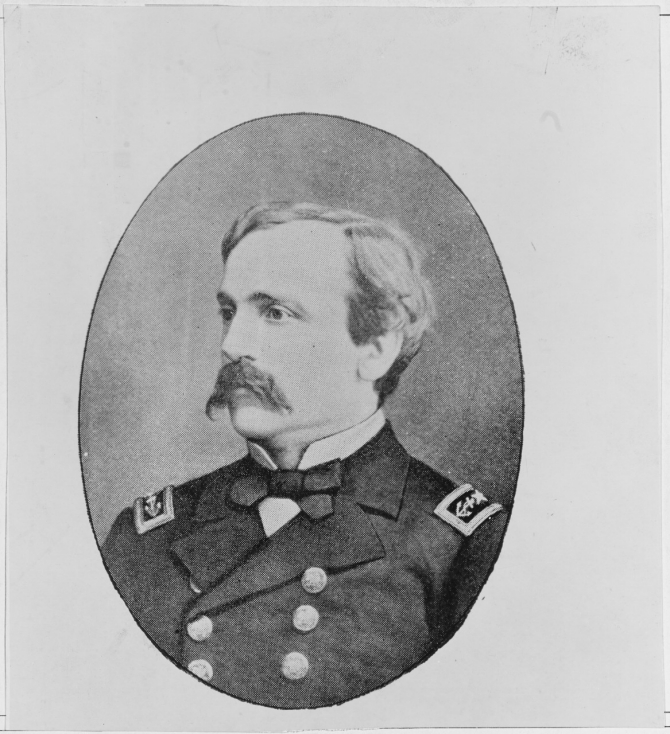
Foxhall Alexander Parker, Jr. (Naval History and Heritage Command Photograph NH 552)
As the Civil War tore apart the country in April 1861, the Parker family was also wrent asunder. Foxhall remained loyal to the Union while his younger brother, William Harwar Parker, who had also been serving in the U.S. Navy up until the outbreak of hostilities, resigned his commission and joined the Confederate States Navy. While William’s motives remain unclear, the Parker family had deep familial roots in the state of Virginia, despite the fact that both brothers had been born in New York City where Comm. Parker had been stationed during his naval service.
Parker helped defend Alexandria, Va., after the disastrous defeat of Union forces at the First Battle of Bull Run [Manassas]. He then saw service with the South Atlantic Blockading Squadron, attempting to prevent southern blockade runners from slipping through Union pickets to bring goods into or out of southern ports as part of General Winfield Scott’s overall “Anaconda Plan” strategy. In the latter part of 1861–1862, Parker served as executive officer of the Washington (D.C.) Navy Yard. His capable handling of administrative duties and other responsibilities brought a good amount of order and confidence to the capitol. Responsible for the building of Fort Dahlgren, Parker also drilled 2,000 seamen in the use of artillery and small arms, and helped train these men for later operations with Adm. Andrew H. Foote’s operations in the Mississippi Flotilla. Promoted to commander on 16 July 1862, Parker became commanding officer of steam gunboat Mahaska and served off Wilmington, N.C. and Yorktown, Va. He then commanded gunboat Wabash off Charleston, S.C. from June-September 1863. From there, Parker was transferred and became commanding officer of a naval battery off of Fort Sumter. He finished the war with the Potomac Flotilla, of which he took command on 31 December 1864.
The 42-vessel flotilla frequently engaged Confederate forces, and began an expedition to Fredericksburg, Va., from 6–8 March 1865. Only a few days later, Parker and his gunboats sailed up the Rappahannock River from 12–14 March, before finishing the war conducting operations in Mattox Creek, Va., from 16–18 March. The Navy Department ordered Parker to stand down on 18 July, and the Potomac Flotilla was officially disbanded on 31 July 1865.
Only a year after the end of hostilities, Parker was promoted to the rank of captain. In 1872, as Commodore and Chief of Staff of the North Atlantic Fleet, he drew up a code of signals for steam tactics. A prolific author later in life, he penned Fleet Tactics Under Steam, The Naval Howitzer Afloat, and other valuable texts used at the Naval Academy, as well as two histories, Fleets of the World (1876), and The Battle of Mobile Bay (1878). Parker served for one year as the commandant of the Boston Navy Yard from 1877-1878 before he was offered and accepted the prestigious position of Superintendent of the Naval Academy, where he became one of the founding members of the U.S. Naval Institute. He died on 10 June 1879 at Annapolis, Md.
I
(Destroyer No. 48: displacement 1,036; length 305'3"; beam 30'4"; draft 9'5"; speed 30 knots; complement 106; armament 4 4-inch, 8 18-inch torpedo tubes; class Aylwin)
The first Parker (Destroyer No. 48) was laid down on 11 March 1912 at Philadelphia, Pa., by William Cramp & Sons; launched on 8 February 1913; and commissioned on 30 December 1913, Lt. Cmdr. Charles P. Nelson in command.
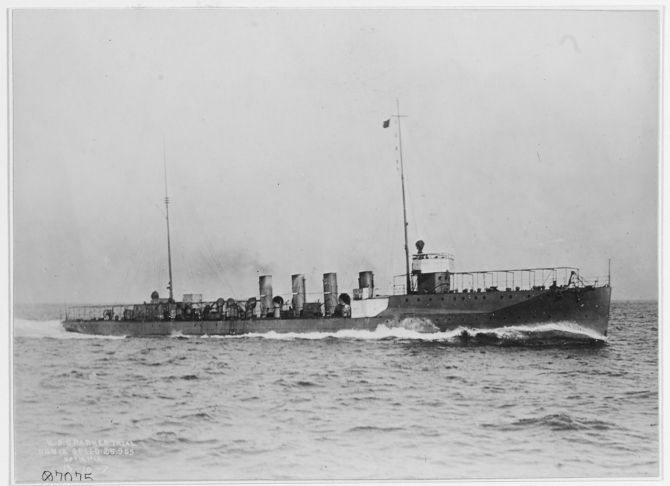
Parker (Destroyer No. 48) makes 25.955 knots on builder's trials, 18 November 1913. No armament was installed on board at that time. (Naval History and Heritage Command Photograph NH 42998)
Parker was attached to the Torpedo Flotilla, Atlantic Fleet, operating off the Atlantic coast during the years of U.S. neutrality in World War I. On 6 April 1914, she was participating in exercises off the coast of North Carolina with sister ships Benham (Destroyer No. 49) and Aylwin (Destroyer No. 47), approximately 15 nautical miles off Diamond Shoals lightship when an explosion through Aylwin’s forward fire room burned three sailors. Benham took the injured men on and steamed for the naval hospital at Norfolk. Aylwin remained afloat but because her crew had abandoned ship, was towed into Naval Station Norfolk by Parker and Navy tug Sonoma. The three sailors, Fireman 2nd Class James H. Eaton, Water Tender Bartholomew Glynn and Fireman 1st Class Everett Harmon all died of their injuries. The crews from the three destroyers raised a total of $250 to help the widow of one of their shipmates with funeral costs.
In early April 1915, Parker and McDougal (Destroyer No. 54) were assigned patrol duties near the New York City Quarantine Station, located at Swinburne Island, which had been created in the lower New York Bay, east of South Beach, Staten Island, for the quarantine of immigrants that had arrived to the U.S. by ship and found to be carrying contagious diseases such as cholera.
Just before the U.S. entered the war, Parker departed winter maneuvers in Cuban waters to join the fleet at Yorktown, Va., in March 1917. As the U.S. entered the war in April, Parker was selected for overseas duty and on 17 June 1917, sailed with Group 4 of the first convoy of U.S. troops of the American Expeditionary Force from New York to Brest, France. The convoy included troop transports Montanan, Dakotan, El Occidente (Id. No. 3307), Edward Luckenbach (Id. No. 1662), Hancock, and oiler Kanawha (Fuel Ship No. 13). In addition to Parker, the escorts included the cruiser St. Louis (Cruiser No.20), and destroyers Ammen (Destroyer No. 35), Flusser (Destroyer No. 20), and Shaw (Destroyer No. 68). As the convoy steamed at a steady pace of 11 knots, a German U-boat attack on the lead elements of the group was thwarted. As the group made its way closer to Europe, they received word that there was heavy U-boat activity off the coast of Brest, and the convoy changed course to Saint-Nazaire, France, where they arrived on 2 July.
From St. Nazaire, Parker steamed to Queenstown, Ireland, joining the U.S. Naval Forces patrolling the Irish Coast. There she escorted convoys safely through the war zone, and assisted vessels in distress, usually after they had been torpedoed by U-boats. From July-November 1918, Parker was attached to the base at Plymouth, England, and operated with U.S. submarine chasers.
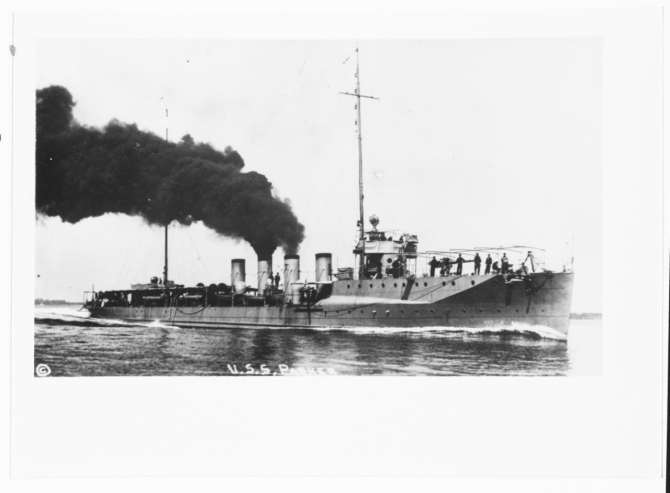
Underway prior to World War I, Parker makes dense smoke from her middle boilers. Probably photographed by Waterman, Hampton Roads, Virginia. Courtesy of Jack Howland, 1985. (Naval History and Heritage Command Photograph NH 100402)
On 3 August 1917, Parker received credit for “probably seriously damaging” an enemy submarine. While in her patrol area at 0212 hours, she took over escort duties for steamships Hobein and Civilian. At 0825 hours, she turned over escort duties to Fanning (Destroyer No. 37) and Perkins (Destroyer No. 26). At 1230, Parker received the approximate location of a U-boat at latitude 52.30 N, longitude 15.10 W. At a speed of 20 knots, she set course for that position and at 1400, having passed through the position, made 10-mile circles in the hopes of locating the enemy sub.
At that time, Parker received an SOS from the steamer Newby Hall, and upon arrival at the steamer noticed that a U-boat had dived six miles north-northwest from Newby Hall’s position. Parker fired two torpedoes at the extreme range of 13,500 yards, just clear of the port side of the allied steamer. She repeated circling in an effort to sight the U-boat and at 1610, turned over Newby Hall over to Burrows (Destroyer No. 29) while Parker returned to look for the submarine. At 1635, a second steamer, Rio Verde, was sighted practically in the identical position where the U-boat was first reported. Parker took Rio Verde under escort at a speed of 8½ knots.
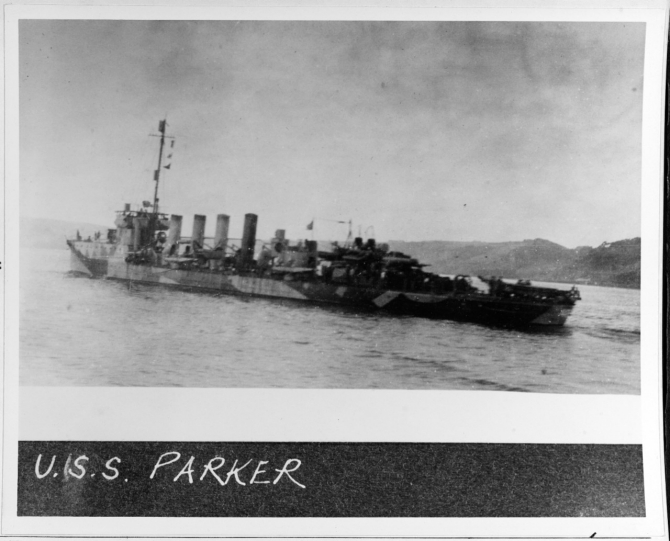
Parker underway during World War I. (Naval History and Heritage Command Photograph NH 64991) Original from the Collection of Mr. Peter K. Connelly. loaned by Mr. William H. Davis, 1967.
At 1850, the U-boat was suddenly sighted bearing true north. Parker immediately changed course to true north in pursuit and when she was only 8,000 yards distant, the enemy submarine submerged and continued on course. The sailors on board Parker noticed a very clearly defined oil slick leading from the U-boat as it proceeded north, and Cmdr. Wilson Brown ordered his helmsman to get in the middle of the slick and follow it down. Upon reaching the end of the slick, the crew watched as the submarine appeared within range and then launched two depth charges. From all evidence, Cmdr. Brown believed, “she was very probably sunk.”
Many of Parker’s crewmembers heard the simultaneous explosions of the depth charges followed by a different sounding explosion, after which air and oil bubbles rushed to the surface, as well as a “heavy scum of oil and particles of what appeared to be cork” floated on top of the water. Parker remained in the vicinity for the next hour and a half in the attempt to confirm any further destruction of the U-boat, but found no further evidence. The sea was described as smooth, and the wind light, while the depth of the water was about 1,200 fathoms. At 2326, she set a course for Berehaven in accordance with her schedule, and they made way at a speed of 20 knots.
Seaman George W. Henning would later receive a letter of commendation for being the “first lookout to sight an enemy submarine which was attacked” on 3 August. Quartermaster’s Mate 3rd Class Clarence A. Lawrence also received a letter of commendation when “he was sent aloft to aid in the directing of movements of the ship in the attack upon the submarine.” A later naval investigation in 1920 downgraded Cmdr. Brown’s optimistic “very probably sunk,” to conform to the British Admiralty’s having considered the German U-boat only being “Probably seriously damaged.” German submarine records do not show a U-boat missing or sunk on 3 August 1917.
On 16 October 1917, as Parker carefully conducted a search for U-boats and was then underway to provide escort duty to four ships from Queenstown, she passed the damaged Cassin (Destroyer No. 43), that had been torpedoed the previous day by U-61 (Kapitänleutnant Victor Dieckmann, commanding) approximately 20 nautical miles off the coast of Mine Head Lighthouse, County Waterford, Ireland. The explosion, that blew off Cassin’s stern, resulted in the death of Gunner’s Mate 1st Class Osmond Ingram, the first U.S. Navy enlisted man to be killed in World War I, as well as the first to be awarded the Medal of Honor (posthumously) for his actions in attempting to release Cassin’s depth charges upon sighting the incoming torpedo and rescue as many of his shipmates lives as possible. Ingram would also be honored by having a destroyer named in his honor in World War II, the first to be named for an enlisted man.
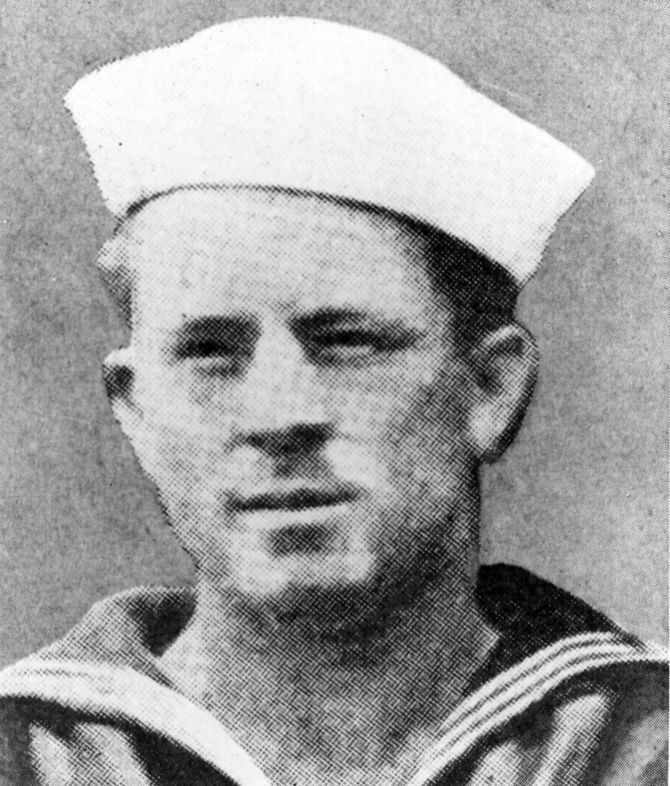
Halftone reproduction of a photograph, copied from an unidentified publication, of Gunner’s Mate 1st Class Osmond K. Ingram. Ingram was posthumously awarded the Medal of Honor for his extraordinary heroism on 15 October 1917, when Cassin (Destroyer No. 43) was torpedoed by the German submarine U-61. (NH 91637, Naval History and Heritage Command Photograph)
On 26 February 1918, the British hospital ship Glenart Castle had steamed from Newport, South Wales, for Brest, France, to bring wounded from the Western Front. Despite witness claims that she sailed lighted and with prominent Red Cross markings that identified her as a hospital ship, she was struck at 0400 in her No. 3 hold by a torpedo fired from the German submarine UC-56 (Kapitänleutnant der Reserve Wilhelm Kiesewetter, commanding). The resulting explosion destroyed a vast majority of the lifeboats on the starboard side, and only seven were launched before the ship sank in seven minutes. Although there were conflicting reports about the number of patients on board at the time of her sinking, 162 people were killed, including all eight female nurses assigned to her. There was also some evidence that the U-boat crew may have intentionally fired upon survivors that made it off Glenart Castle, as one deceased crewmember was found in a lifejacket with bullet wounds to his neck and upper thigh. Parker got underway at once when alerted there was a ship in danger in the Bristol Channel, and had a role in helping rescue some of the 32 survivors. The British Parliament, the Admiralty, and the U.S. naval authorities all commended Parker’s men for their gallantry.
From July-November 1918, Parker was attached to the base at Plymouth, England, and operated with U.S. submarine chasers. On 1 November 1918, Parker sailed from Plymouth for Gibraltar but returned to Plymouth upon signing of the Armistice on 11 November. Thereafter Parker carried mail and passengers between Plymouth and Brest. She made a cruise to German ports in early 1919 to implement the terms of the armistice, before steaming to the Baltic Sea to assist members and vessels of the Food Administration.
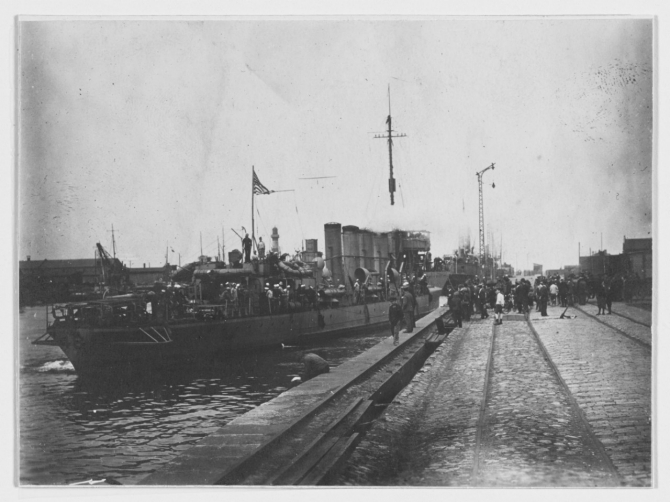
Parker at Libau (Liepaja), Latvia, during her Baltic cruise, circa Spring 1919. Photographed by Zimmer (Naval History and Heritage Command Photograph NH 3013)
Parker sailed for New York on 20 July 1919, and upon arrival was assigned to Destroyer Squadron 1, Atlantic Fleet. She was assigned to Norfolk in the latter part of 1919, and in July 1920 was operating in the Mediterranean when she played a role in the search for Paul and Harriet Fisher Nilson, an American missionary couple thought to have been abducted by Turkish Nationalists. Parker steamed to the port city of Mersina, Turkey, to demand the release of the couple, which was granted after they had been held for three days. After making a final cruise up the coast to Newport, R.I., the destroyer was decommissioned on 6 June 1922.

Destroyer Squadron 14 in the North River, off New York City, 20 May 1921. Panoramic photograph by Himmel & Tyner, New York. U.S. Navy ships present are (from left to right): Cummings (Destroyer No. 44); Wainwright (Destroyer No. 62); Parker (Destroyer No. 48); Balch (Destroyer No. 50); McDougal (Destroyer No. 54); Ericsson (Destroyer No. 56); and the tender Dixie, the squadron flagship. Note what appears to be a yacht club in the lower left. (Naval History and Heritage Command Photograph NH 103514)
Parker was stricken from the Navy List on 8 March 1935, and was scrapped and sold on 23 April 1935 at the Philadelphia Navy Yard in accordance with the terms of the London Treaty for the Limitation of Naval Armament.
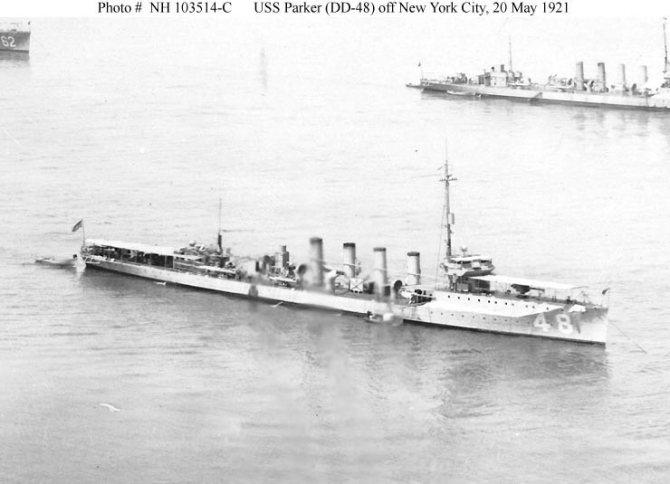
Close-up of Parker in the North River off New York City, 20 May 1921 (Cropped from NH 103514, a panoramic photograph by Himmel & Tyner, New York, Naval History and Heritage Command Photograph NH 103514-C)
Commanding Officers Dates of Command
Lt. Cdr. Charles Preston Nelson 30 Dec 1913 – 18 Mar 1915
Lt. Cdr. Ward Kenneth Wortman 18 Mar 1915 – 8 Apr 1916
Lt. William Donaldson Greetham 8 Apr 1916 – 27 Jun 1916
Lt. Halsey Powell 27 Jun 1916 – 6 Oct 1917
Lt. Cdr. Frank Robert McCrary 6 Oct 1917 – 8 May 1918
Lt. Cdr. Wilson Brown, Jr. 8 May 1918 – 15 Jan 1919
Lt. Cdr. Wallace Benjamin Phillips 15 Jan 1919 – 8 May 1919
Lt. Cdr. John Howard Wellbrock 11 May 1920 – 6 Jun 1921
Lt. Harold Samuel Klein 6 Jun 1921 – 1 Jan 1922
Lt. David Carl Fox 1 Jan 1922 – 6 Jun 1922
Guy Nasuti
10 November 2016


